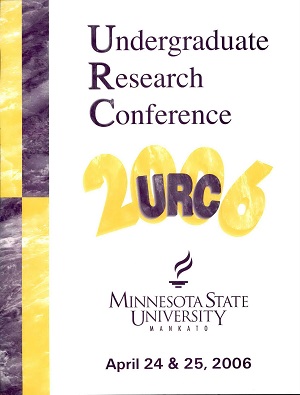An Investigation into Human Decomposition in a Cold Climate Region: A Winter Ecosystem Effects on Postmortem Interval Estimates
Location
CSU North Ballroom
Start Date
24-4-2006 10:30 AM
End Date
24-4-2006 12:30 PM
Student's Major
Anthropology
Student's College
Social and Behavioral Sciences
Mentor's Name
Kathleen Blue
Mentor's Department
Anthropology
Mentor's College
Social and Behavioral Sciences
Description
In the medicolegal community, establishing the postmortem interval (PMI) is critical. It not only aids in assistance with identification of human remains; it can uphold or impeach a suspect's testimony. Prior investigations into the decomposition rate for human remains have been extensive but localized. Previous research done has been chiefly limited to temperate and arid environments. Though beneficial, this work does not encompass the ecosystems that comprise the Northern United States and more specifically Minnesota. Minnesota is located in the High Plains Region of the US and is home to a large number of aquatic environments comprised of lakes and rivers. The average winter temperature is near or below freezing for multiple months. Explorations for PMI in terrestrial and aquatic settings within regions that display a cold climate have been insufficient. Conclusions from aforementioned research have routinely been limited to the statement: "decay is retarded in cold temperatures due to decrease in insect activity." This project first examined the limitations previously investigated in estimating the postmortem interval (PMI) with regards to terrestrial and aquatic settings in a cold climate. Second, I explored the ecological environment of southern Minnesota, specifically temperature, insect, carnivore and rodent activity, all of which would affect decay rates during the winter season. Finally, possible effects from multiple freeze-thaw cycles with respect to human decomposition were investigated. The purpose of this research was to add to the PMI database and aid in a establishing a more complete system for estimating time of death.
An Investigation into Human Decomposition in a Cold Climate Region: A Winter Ecosystem Effects on Postmortem Interval Estimates
CSU North Ballroom
In the medicolegal community, establishing the postmortem interval (PMI) is critical. It not only aids in assistance with identification of human remains; it can uphold or impeach a suspect's testimony. Prior investigations into the decomposition rate for human remains have been extensive but localized. Previous research done has been chiefly limited to temperate and arid environments. Though beneficial, this work does not encompass the ecosystems that comprise the Northern United States and more specifically Minnesota. Minnesota is located in the High Plains Region of the US and is home to a large number of aquatic environments comprised of lakes and rivers. The average winter temperature is near or below freezing for multiple months. Explorations for PMI in terrestrial and aquatic settings within regions that display a cold climate have been insufficient. Conclusions from aforementioned research have routinely been limited to the statement: "decay is retarded in cold temperatures due to decrease in insect activity." This project first examined the limitations previously investigated in estimating the postmortem interval (PMI) with regards to terrestrial and aquatic settings in a cold climate. Second, I explored the ecological environment of southern Minnesota, specifically temperature, insect, carnivore and rodent activity, all of which would affect decay rates during the winter season. Finally, possible effects from multiple freeze-thaw cycles with respect to human decomposition were investigated. The purpose of this research was to add to the PMI database and aid in a establishing a more complete system for estimating time of death.
Recommended Citation
Sims, Lecia. "An Investigation into Human Decomposition in a Cold Climate Region: A Winter Ecosystem Effects on Postmortem Interval Estimates." Undergraduate Research Symposium, Mankato, MN, April 24, 2006.
https://cornerstone.lib.mnsu.edu/urs/2006/poster-session-A/4



